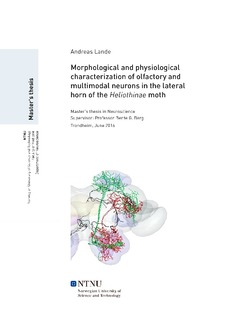Morphological and physiological characterization of olfactory and multimodal neurons in the lateral horn of the Heliothinae moth
Master thesis
Permanent lenke
http://hdl.handle.net/11250/2437099Utgivelsesdato
2016Metadata
Vis full innførselSamlinger
Sammendrag
Through several hundred millions of years, evolution has developed and moulded the chemical senses in animals across our planet, echoing the ever changing environment. In a windy and turbulent field of flowers, insects that try to localize a single flower species embark on a challenging enterprise. Their brain and nervous system have developed key mechanisms to solve such problems. These mechanisms are seen conserved across species, not only limited to insects, but also in fishes and mammals, including humans. To understand how these mechanisms are realized, we must understand the morphological and physiological properties of the olfactory circuits. In this thesis, I have used intracellular recording and iontophoretic staining to investigate neurons in the lateral horn, a higher-order region of the insect brain. This was done in vivo, using two related Heliothinae moth species as a model organism. The injected fluorescent dye was visualized using confocal laser-scanning microscopy. I show both novel findings on the morphology of antennal-lobe projection neurons, and higher-order neurons innervating the lateral horn, as well as findings that complement previous work. Furthermore, this study shows that neurons in the lateral horn are most responsive to natural odour mixtures, like headspace sample from sunflower and the ideal pheromone mixture emitted by the female of the same species. In addition, I found that 19% of neurons in the lateral horn responding to antennal odourstimulation also respond to a light stimulus. Finally, a neuronal recording in one female of the species Helicoverpa armigera responded to single pheromone components and the ideal mixture, signifying the presence of pheromone autodetection in females of this species.
